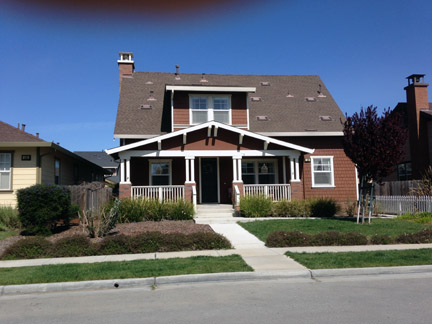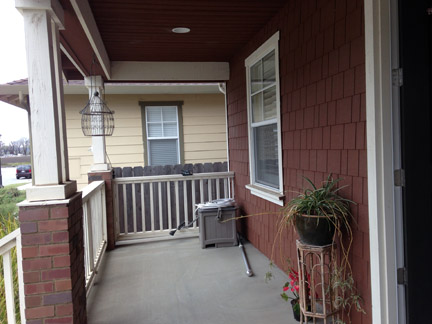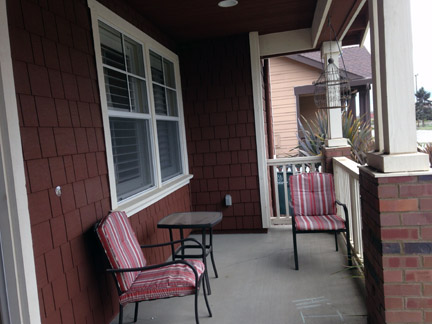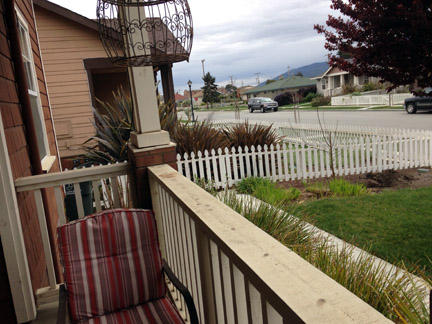FILMED APRIL 2013
Several weeks into our preproduction period for THE RIGHT REGRETS I was talking to my brother on the telephone, giving him the latest on our search for a porch. In the background I heard my sister-in-law call out, “Why doesn’t he use his own porch?” It’s true! I have a large porch with a swing and a rocker, exactly the setting I was seeking for our production, but the requirements for the location demanded more. I also needed a street in front of the porch where I would be staging the arrival and departure of one car and the departure of a second one, and my street didn’t work. Weeks earlier, in fact just two weeks after we began prepping, we were looking for something even more complicated. In the original script Lily lived in a duplex with Vera residing in the other half, and the two shared a large porch. That was the request at our first production meeting: find a duplex with a large porch in a quiet residential neighborhood. One member of the staff eagerly presented a solution to our problem. His uncle owned a duplex in Santa Cruz, and he assured us there would be no difficulty in securing permission to use it. Since he lived in Santa Cruz, he would check it out on his return that very day. The next day he reported he had gone to the residence. It was, as he had described, a duplex, but it didn’t fulfill our needs; it didn’t have a porch. So much for the observation awareness of an aspiring filmmaker, and that was the rocky beginning for what turned out to be a long and futile search. Our staff claimed they were covering Monterey, Pacific Grove and Salinas. I suggested they check out Aptos, Soquel and look further in Santa Cruz — all to no avail; and during this passage of time and as our start date to begin filming approached, the permits still had not been obtained to film David Potigian’s house on Larkin Street in Monterey, the restaurant Toastie’s in Pacific Grove was still in negotiation, and we were still waiting for confirmation to film at the Lighthouse in Big Sur and on Garripata Beach. True we had Dino Cocalis’ house set for Charles’ den, the house on Dolores Street in Carmel for the interior of Lily’s house and the house and lake at White Rock (although the problem of filming at the lake was still in our unsuspecting future), plus the problem of finding another location where we could film our Book Fair, which I will be covering in the next post.
There comes a time when you have to face the reality that you’re not going to find what you’re looking for. I suggested we change our duplex to a single structure for Lily and move Vera to a guesthouse, which we would never see, in the rear. Now the search was simplified; all I needed to do was make a simple change in dialogue in the Book Fair scene noting this new arrangement, make some adjustments in staging and notify our staff to start looking for a single house with a large porch on a quiet residential street. This was done, and the search continued – with the same non-results. Most of my friends here in Carmel were aware of our fruitless endeavors. I was reporting our lack of progress to my friend Rohana in David’s Gallery Sur, when she asked if I had scouted the Spreckels area in south Salinas. I had not; I didn’t know there was a Spreckels area in south Salinas, so Rohana gave me the directions of how to go there, and the next morning Marlyn and I hopped in her Volvo and headed for the Spreckels area in south Salinas. We turned off of Highway 68 as instructed and soon found ourselves in a cornucopia of streets lined with houses with porches. It was not a large area; the population in the 2010 census was less than 700. I was soon to learn that it was a small community of homes, surrounded by farmland that had been built to house the workers at the Spreckels Sugar Plant that was visible in the distance. I did not go closer, but the plant did not seem to be in operation. Out came my iPhone, and I started taking pictures. The homes were very similar — in a way too similar, almost like a tract of porched houses. Again my concern was to find a house with a street that would be suitable for what I had to stage. I photographed five homes, and Marlyn and I returned to Carmel, where I e-mailed the information to our location crew. I sent photographs and addresses, listed in the order of my preference. The next day one of the staff drove to the Spreckels area of south Salinas and started knocking on the door of the houses I had selected. House #1: no one was home. Ditto house #2 and house #3. Success at house #4; not only was the door opened when he knocked, the owner was delighted to offer his home for our use. After weeks of searching Lily finally had a porch to add to her interior.





Lily’s porch in the Spreckels area of south Salinas was scheduled for our 7th day of filming. It was the first of the two days that the character Vera would work. Marlyn wrote the role of Vera for her friend, the actress Ann Morgan Guilbert. I knew Ann. We had worked together many years before on an episode of THE PARTRIDGE FAMILY. As we drew near the start of filming, Marlyn received word from Ann that she didn’t want to do it. Marlyn was not surprised; she had expressed concern about Ann’s physical well-being. She had warned me that Ann would probably need to use a walker. That didn’t concern me – that would be part of her character. This late minute withdrawal also didn’t concern me; because of Marlyn’s forewarning I had a replacement in mind. In 1986 I had directed a production of WATCH ON THE RHINE for Theatre 40 in Beverly Hills. Dorothy Sinclair had played the French companion, and we have remained friends during the intervening 27 years. Dorothy was aware of and a fan of Marlyn’s past independent films, and when I e-mailed her the offer to come aboard to play Vera, she immediately without any hesitation said, “YES.”
Tuesday morning, April 9, cast and crew assembled early in the Spreckels area of south Salinas. Since we knew Maxwell had filmed the day before in southern California on the program, NCIS, we weren’t sure whether he had returned to the Peninsula the night before or whether he was driving up that morning, so we gave him a later call. There were six scenes involving only Marlyn and Dorothy, so there was not a lack of work to be done. Dorothy was a joy. She fit right in as if she had been working with us from day one. We zipped through our work and had most of the Lily-Vera scenes completed by the time we broke for lunch. By that time Maxwell had arrived at the location. As I remember, he had returned to the Peninsula the previous night after completing his work on NCIS.
Marlyn has made no secret of the fact that THE RIGHT REGRETS is based on a true relationship. I discussed in my post, THE RIGHT REGRETS: Casting, how our brief involvement with the actor Michael York altered the character of Charles. For me Michael’s most significant suggestion was in the following scene when Charles unexpectedly drives up to Lily’s house in his Green Rover:
Vera goes in. Lily turns and watches Charles park. She goes to greet him .As she offers her hand in greeting, he does a little two step with her around the car then suddenly stops, takes her face in his hands and very, very gently kisses her.
13 INT VERA’S LIVING ROOM LATE AFTERNOON
Vera peeks through the curtains and takes photos of the two love birds.
VERA
Say what you want, Lily, he ain’t a lousy kisser. CUT TO:
Michael felt Charles shouldn’t kiss her at that meeting. That resonated with me. Lily and Charles had briefly met at a Book Fair weeks before and had spoken only once since when Charles unexpectedly phoned her from his home in Canada. Losing the brashness of the original “Charles” (and Vera and her camera), how did I see these two people greeting each other?
At the start of editing two weeks after wrapping photography, I wanted to begin by assembling the final dramatic, climactic sequences, so that first day we worked on the scenes that comprised the last eight and a half pages of the script. Checking the running time at the end of the day, I was told the rough cut of those pages ran to just under 20 minutes. My instructions were that the maximum running time for short films for festivals was 40 minutes. Allowing for a minute for the end credits, I realized that the first 19 pages of script still to be edited could run no longer than 19 minutes. Starting at our next editing session when we began assembling the opening of the film, I kept a running check as we progressed: running time versus page count. Halfway through those 19 pages I knew we were going to be long, and that an entire sequence would have to go. I considered the ending scenes we had edited that first day to be untouchable, so I would have to find the scene to be eliminated in the first part of the film. It was not going to be easy. We were working with a very tight script. I decided the likeliest candidate for omission was the breakfast scene on the morning after Charles’ arrival, and it went. Here it is, fresh from the cutting room floor, wind-blown and without a corrected sound track:
With the two film editors up in San Francisco and available to come down to Carmel only on those days when they didn’t have more lucrative employment, it would be three weeks before we met again to complete our first assemblage. There were several sessions that week, and we ended up with our first rough cut at 40 minutes and 30 seconds. I was thrilled. Some general tightening would bring that down easily to 37 or 38 minutes. And then the boom fell. Marlyn told me although the film festivals had a 40-minute maximum running time for short films, our production manager Grant Ellis had just notified her that the Screen Actors Guild’s maximum time to qualify as a short film was 35 minutes including credits. We scheduled two more editing sessions – Brandon would come down the next Wednesday and Taylor would come down on Friday, so on Wednesday, May 22, Brandon arrived with his computer at 10:00 am, and we went to work. We had to squeeze out 6 minutes and 30 seconds without harming our film. We worked, scene by scene – a tightening here, a short elimination there, maintaining count along the way of how much of our 6 minutes and 30 seconds we were eliminating. I realized just making trims was not going to give me the total I needed. Another entire sequence needed to go. I found that sequence, and it was cut. But it has raised a serious question in my mind. Before I continue, I must state I am vehemently pro-union and pro-labor. I am a member of the Directors Guild of America, one of the finest labor organizations in the country. I understand Screen Actors Guild’s placing their time limit. But actors do short films like this for more than the paltry sum of money they receive. They do them to keep working. They do them to get to play roles that commercial films may not be offering them. And they do them for the SHOWCASING and possible future employment that might result. Eliminating the sequence that I had to cut did not harm this film. So who was most affected by the following sequence ending up on the cutting room floor? Wouldn’t Marlyn and Maxwell and Dorothy benefit from the added screen time this sequence gave them? Wouldn’t it make sense for the Guild to extend its maximum limit to match that of the film festivals?



I am so glad to have the opportunity to see the deleted scenes. I and my husband are one of the donors to the movie and a Medford friend of Marlyn’s. We have seen her first two short films and are very aware of Marlyn’s writing talent as well as her acting. Good luck on the final cut. We are looking forward to seeing the finished product. You are so well known for your excellent directing through the years. How wonderful you consented to do “The Right Regrets”.
Thanks for the look inside at the deleted scenes.
What a shame to cut such a lovely scene.